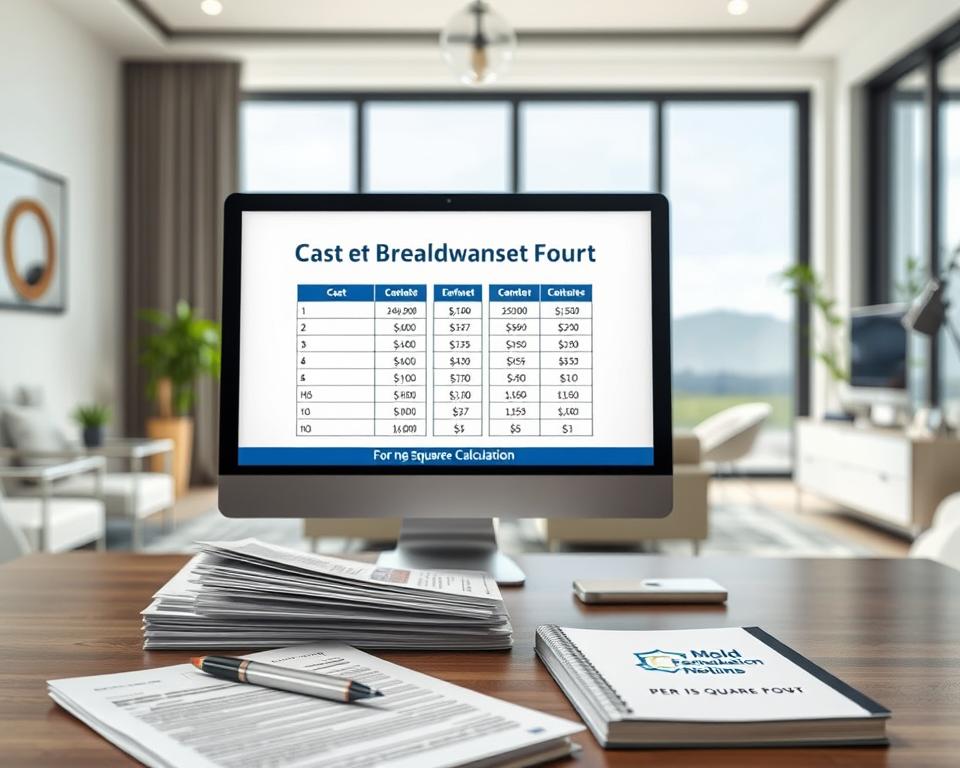Could your home’s hidden issue be costing you more than just peace of mind? Many property owners overlook the critical step of calculating remediation expenses before starting a project. Understanding the financial scope upfront ensures informed decisions and avoids surprises.
Professional assessments often factor in two main variables: the size of the affected area and the severity of the problem. Larger spaces or deeply rooted issues typically require more resources, impacting overall expenses. Labor, specialized equipment, and containment materials all contribute to the final estimate.
Accurate measurements matter because pricing structures vary. Some providers base fees on square footage, while others consider complexity. This article breaks down how these variables interact and what homeowners should anticipate during the planning phase.
Key Takeaways
- Accurate assessments depend on room dimensions and contamination severity.
- Labor and material costs are included in preliminary quotes.
- Square footage remains a common pricing metric for remediation work.
- Unexpected complications can influence final project expenses.
- Comparing multiple estimates helps identify fair market rates.
Understanding Mold Removal and Its Costs
Hidden dangers in your living space often reveal themselves through musty odors or visible spores. Addressing these issues requires understanding how professionals calculate service fees. Variables like structural damage and contamination type play critical roles in shaping budgets.
Factors Influencing Mold Remediation Prices
Location significantly impacts expenses. Colonies behind drywall or under flooring demand more labor than surface-level growth. Contractors may charge extra for:
- Cutting through materials to access hidden colonies
- Protecting unaffected areas during treatment
- Disposing of contaminated building components
Another key factor involves the organism’s classification. Toxic black varieties require stricter safety protocols than common allergenic types. These precautions increase both time and material investments.
Area Size and Extent of Mold Infestation
Small patches under 10 square feet might cost $500-$1,500. Entire basements exceeding 100 square feet often exceed $6,000. Severely compromised structures needing reconstruction escalate prices further.
Consider a bathroom with recurring moisture issues versus an attic with years of undetected growth. The latter scenario typically involves:
- Advanced air quality testing
- Replacement of insulation and wooden beams
- Multiple rounds of antimicrobial treatment
Professionals assess penetration depth into materials before quoting. Superficial growth on non-porous surfaces costs less than colonies embedded in wood or drywall.
Benefits of a Free Estimate for Mold Removal Projects
Are you aware of the financial safeguards available before tackling household contaminants? Preliminary assessments provide clarity for homeowners navigating remediation processes. These evaluations reveal potential expenses tied to average cost mold treatments while outlining service expectations.
Requesting detailed bids allows comparison of regional pricing trends. Many certified providers include itemized breakdowns covering labor, containment barriers, and post-treatment inspections. This transparency helps identify outliers in market rates.
Reputable mold remediation companies use standardized measurement methods during evaluations. Consider this comparison of typical assessment components:
| Service Provider | Scope Analysis | Cost Range |
|---|---|---|
| Regional Specialist A | Air quality tests + surface sampling | $1,200–$2,800 |
| National Chain B | Infrared moisture detection | $900–$3,100 |
| Local Contractor C | Visual inspection + lab reports | $750–$2,400 |
Homeowners who get free estimates often discover budget-friendly solutions. These consultations highlight salvageable materials versus necessary replacements. They also clarify warranty terms and preventive measures.
Multiple bids empower informed decisions by exposing varied approaches to identical problems. This practice reduces financial risks while ensuring alignment with industry standards. Always verify licensure and insurance during evaluations.
Free Estimate for Mold Removal Per Sq Ft
What determines the final price tag when addressing biological growth in your property? Square footage-based calculations offer a standardized approach favored by remediation specialists. This method accounts for localized contamination patterns while providing predictable budgeting frameworks.
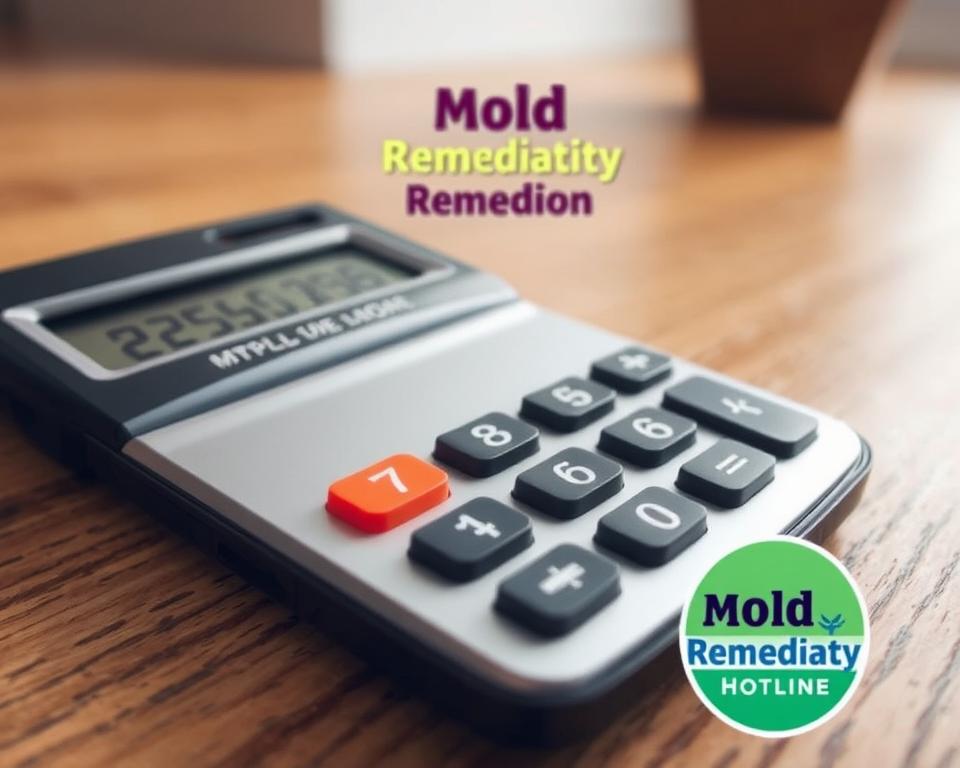
Why Per Square Foot Pricing Works
Containment areas rarely span entire structures. Charging by measurable zones allows technicians to focus resources where needed. A 150-square-foot attic section with visible growth, for example, demands different strategies than a 30-square-foot bathroom corner.
Precise measurements eliminate guesswork in house mold remediation projects. Contractors assess penetration depth and material porosity before calculating labor hours. Transparent per-unit rates let homeowners verify:
- Service boundaries within affected spaces
- Equipment requirements for specific zones
- Material costs tied to contaminated surfaces
| Area Size | Typical Cost Remove Mold | Included Services |
|---|---|---|
| 10-50 sq.ft. | $8–$12/sq.ft. | Surface cleaning, air filtration |
| 50-100 sq.ft. | $10–$15/sq.ft. | Partial demolition, HEPA vacuuming |
| 100+ sq.ft. | $12–$20/sq.ft. | Structural drying, material replacement |
Standardized cost per square metrics simplify bid comparisons across providers. Homeowners quickly identify outliers in labor rates or containment methods. Industry leaders like SERVPRO and PuroClean use this model to balance fairness with operational costs.
Square-footage transparency builds trust during house mold remediation consultations. Clients see how expanding project scopes affect budgets. This clarity helps prioritize critical zones when planning phased treatments.
Components of Mold Remediation Costs
Breaking down remediation expenses reveals critical insights for homeowners planning cleanup projects. Three primary elements shape most quotes: workforce requirements, material investments, and specialized tools. Hidden fees often emerge during later stages, making upfront clarity essential.
Labor, Materials, and Equipment Expenses
Professional services allocate 40-60% of budgets to skilled technicians. Complex cases requiring protective gear or overtime work increase hourly rates. Including labor materials like antimicrobial sprays and replacement drywall typically accounts for 25-35% of total expenses.
High-efficiency equipment constitutes 15-25% of removal cost breakdowns. Industrial dehumidifiers and air scrubbers require significant upfront investments. This table illustrates typical allocations:
| Cost Component | Percentage of Total | Examples |
|---|---|---|
| Workforce | 45% | Containment setup, surface treatment |
| Supplies | 30% | Biocides, personal protective equipment |
| Machinery | 25% | HEPA vacuums, moisture meters |
Additional Fees and Disposal Costs
Many homeowners overlook hazardous waste transportation charges. Contaminated materials like insulation often require EPA-approved disposal methods. Some states mandate certified landfill fees ranging from $200-$800 per truckload.
The average cost increases when structural repairs become necessary. Water-damaged subfloors or compromised wall cavities add 18-32% to initial estimates. Always request detailed breakdowns showing line items for:
- Containment barrier installation
- Post-remediation verification tests
- Biodegradable waste bags
Understanding these components helps property owners evaluate bids effectively. Transparent providers separate removal cost factors from optional upgrades like mold-resistant paints.
Cost Breakdown by Affected Areas and Home Locations
Where contamination strikes your home significantly impacts cleanup expenses. Different spaces present unique challenges that influence pricing structures. Let’s examine how location-specific factors shape budgets.
Key Price Drivers in Common Problem Zones
Bathrooms often require $500–$2,000 for treatment. High humidity enables surface-level growth, simplifying some tasks. However, hidden leaks behind tiles can double expenses if water damage compromises subflooring.
Attics and basements typically range from $1,500–$6,000. These areas frequently harbor deep-seated issues requiring:
- Insulation replacement
- Structural drying
- Multiple antimicrobial applications
Crawl space costs average $1,800–$4,500 due to limited access and persistent dampness. Technicians often install vapor barriers to prevent recurrence. Compare regional pricing trends using this breakdown:
| Area | Cost Range | Key Factors |
|---|---|---|
| Bathroom | $500–$2,000 | Ventilation quality, leak severity |
| Basement | $2,200–$6,000 | Foundation cracks, drainage issues |
| Attic | $1,800–$5,500 | Roof leaks, insulation type |
| Crawl Space | $1,800–$4,500 | Access difficulty, vapor barriers |
Severe water damage increases all categories by 30-60%. Always request area-specific assessments rather than whole-house quotes. This approach pinpoints problem zones while controlling budgets.
Evaluating Mold Types and Their Remediation Challenges
Did you know the color of those fuzzy patches in your home could dictate your family’s health risks? Biological growth comes in various forms, each posing unique threats. Identifying the specific variety determines both safety protocols and treatment methods.
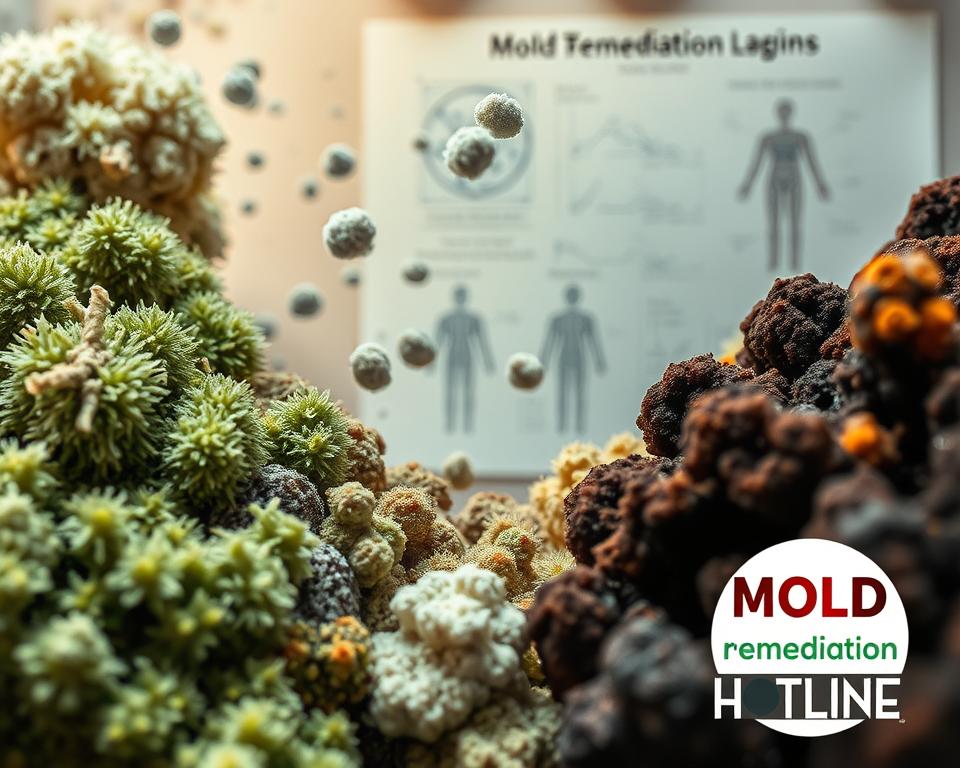
Comparing Black Mold and Other Varieties
Stachybotrys chartarum, commonly called black mold, stands out for its dark greenish-black hue and slimy texture. This aggressive type releases mycotoxins that cause health problems like chronic coughing, fatigue, and neurological issues. Unlike allergenic varieties, it requires full containment during removal.
Other common types include:
| Mold Type | Appearance | Health Impact | Removal Difficulty |
|---|---|---|---|
| Aspergillus | Powdery, gray-green | Respiratory irritation | Moderate |
| Cladosporium | Olive-brown spots | Allergy triggers | Low |
| Penicillium | Blue-green fuzzy | Asthma flare-ups | Moderate |
Surface-level growth like Cladosporium often appears on grout or wood. However, mold found behind walls or under flooring usually indicates deeper contamination. Professionals use infrared cameras and moisture meters to locate hidden colonies.
Black mold requires specialized cleaners and protective gear due to its toxicity. Non-toxic varieties might respond to DIY solutions, but misidentification risks exposure. Always test suspicious growths before attempting cleanup.
Understanding these differences helps homeowners prioritize actions. While some types merely cause health discomfort, others demand immediate professional intervention. Regular inspections prevent minor issues from escalating into hazardous situations.
The Role of Professional Mold Remediation Companies
When confronting persistent biological growth, expertise matters more than most homeowners realize. Specialized teams bring structured solutions that DIY methods can’t match. Their approach prevents cross-contamination while addressing root causes.
Essential Credentials for Effective Treatment
Top-tier mold remediation companies hold certifications from respected organizations. The Institute of Inspection, Cleaning and Restoration Certification (IICRC) sets industry standards for safe practices. Restoration Industry Association (RIA) and National Organization of Remediators and Mold Inspectors (NORMI) credentials also validate technical proficiency.
These certifications ensure technicians understand:
- Containment protocols to limit spore spread
- Proper use of antimicrobial agents
- Advanced moisture detection techniques
| Certification | Focus Area | Renewal Cycle |
|---|---|---|
| IICRC S520 | Damage assessment standards | Every 4 years |
| RIA CMP | Project management | Annual |
| NORMI Pro | State-specific regulations | Biennial |
Reputable companies cover mold challenges through multi-stage processes. They use infrared cameras to locate hidden colonies and air scrubbers to purify environments. This reduces health risks compared to partial treatments.
Always verify a firm’s insurance coverage and service guarantees. Licensed providers typically offer post-remediation inspections. These steps confirm that certified mold remediation meets safety benchmarks.
DIY vs. Professional Mold Removal
Is tackling household fungi yourself worth the risk? Small surface patches under 10 square feet might seem manageable with store-bought cleaners. However, improper techniques often spread spores to unaffected areas, worsening contamination.
Diy mold removal becomes risky when dealing with porous materials or toxic varieties. Attempting to scrub black growth off drywall or insulation without containment barriers frequently leads to:
- Incomplete eradication
- Cross-contamination risks
- Increased long-term costs
Consider these factors when deciding whether to remove mold home or hire experts:
| Approach | Cost Range | Project Scope | Safety Level |
|---|---|---|---|
| DIY | $15–$50 | Non-porous surfaces under 5 sq.ft. | Low (no PPE) |
| Professional | $500–$6,000 | Porous materials or areas over 10 sq.ft. | High (full containment) |
Health complications often arise from inadequate protective gear during diy mold removal. Allergenic particles become airborne during scrubbing, potentially triggering asthma attacks. Professionals use respirators and negative air machines to prevent exposure.
Decisions should hinge on depending job size and contamination depth. While baking soda solutions might clean bathroom tiles, structural infestations demand industrial-grade equipment. Certified teams also address moisture sources to prevent recurrence.
Homeowners attempting to remove mold home face hidden costs like repeated treatments and medical bills. Always assess spore types and affected materials first. Projects exceeding personal skill levels or depending job size thresholds warrant professional bids.
Analyzing Pricing Structures in Mold Remediation
Unraveling the cost factors behind cleaning up biological hazards requires insight. Service providers use distinct calculation methods that reflect project complexity and regional standards. Two primary models dominate the industry: flat-rate packages and area-based formulas.
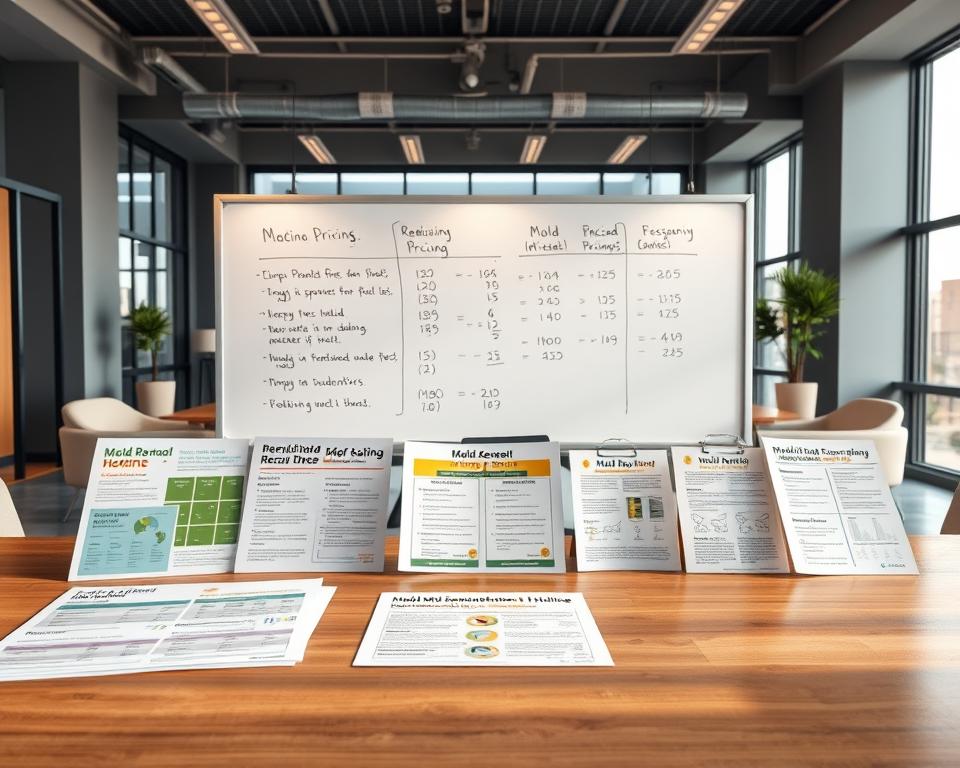
Flat-rate pricing often applies to contained spaces like bathrooms or closets. Contractors bundle labor, materials, and equipment into single fees ranging from $1,200–$3,500. This approach simplifies budgeting for predictable scenarios with minimal structural damage.
Larger projects frequently use per square measurements. This method accounts for variations in contamination density across zones. A 300-square-foot basement might cost $4,500–$6,000, while whole-home treatments average $10,000–$30,000. Consider this comparison:
| Project Scope | Pricing Model | Typical Range |
|---|---|---|
| Single room | Flat fee | $1,800–$3,200 |
| Multi-room | Per unit area | $12–$18/sq.ft. |
| Structural repairs | Hybrid | $25–$40/sq.ft. |
Labor typically consumes 45-60% of remediation costs, with antimicrobial treatments and air filtration systems making up 20-35%. Complex cases involving wall cavities or HVAC systems add 15-25% to baseline estimates.
Understanding these frameworks helps homeowners decode bids effectively. Always request itemized breakdowns showing how providers allocate expenses across tasks. This transparency reveals whether premium rates reflect superior materials or unnecessary markups.
Impact of Environmental Factors on Mold Growth
What transforms a cozy living space into a breeding ground for unseen threats? Humidity levels above 60% create ideal conditions for biological contaminants to thrive. Research shows that 55% of homes with home high humidity issues develop visible growth within six months.
Persistent moisture weakens building materials like drywall and wood. Over time, this leads to structural decay and costly repairs. The EPA recommends maintaining indoor humidity between 30-50% to inhibit spore development.
Individuals with compromised immune systems face heightened risks. Airborne particles from colonies can trigger respiratory distress or chronic allergies. Children and elderly residents often experience more severe symptoms compared to healthy adults.
| Humidity Range | Risk Level | Recommended Actions |
|---|---|---|
| Below 50% | Low | Routine ventilation checks |
| 50-60% | Moderate | Dehumidifier installation |
| Above 60% | High | Professional moisture assessment |
Preventive measures reduce long-term health and property risks. Simple steps like fixing leaks promptly and using exhaust fans disrupt mold growth cycles. Advanced solutions include moisture-resistant building materials during renovations.
Environmental monitoring systems provide real-time humidity data. These devices alert homeowners to sudden spikes before damage occurs. Combining technology with regular inspections creates a proactive defense against contamination.
Insurance and Financing Considerations for Mold Removal
Does your policy shield you from unexpected cleanup expenses? Many homeowners discover gaps in their protection when addressing biological contamination. Most standard policies exclude mold-related claims unless directly tied to water damage flood incidents or sudden pipe bursts.
Understanding Coverage and Homeowner Options
Covered homeowners insurance typically requires proof that contamination resulted from a covered peril. For example, storm-related flooding or appliance leaks might qualify. Gradual humidity buildup or neglected maintenance usually doesn’t meet eligibility criteria.
Review these common scenarios to gauge potential coverage:
| Cause | Policy Inclusion | Documentation Needed |
|---|---|---|
| Burst pipes | Often covered | Plumber’s report, repair invoices |
| Roof leaks | Case-dependent | Weather records, inspection photos |
| Chronic dampness | Rarely covered | Maintenance history |
When remediation covered homeowners needs exceed policy limits, consider these alternatives:
- Specialized environmental hazard riders
- Home equity lines of credit
- Flexible payment plans from certified contractors
Always request written clarification from your insurer before starting work. Some providers require pre-approval for water damage flood restoration services. Third-party financing options often feature competitive rates for urgent projects not qualifying under covered homeowners insurance terms.
Using Technology and Equipment for Efficient Remediation
Modern tools have transformed how experts tackle airborne contaminants during cleanup operations. Advanced systems now address microscopic threats traditional methods often miss. This shift improves both safety standards and long-term results.
The Benefits of Air Scrubbers and HEPA Vacuums
High-efficiency particulate air (HEPA) filters capture 99.97% of particles as small as 0.3 microns. These vacuums prevent spore redistribution during surface cleaning. Air scrubbers complement this process by cycling contaminated air through multiple filtration stages.
Professionals may need specialized setups in spaces with limited ventilation or extensive contamination. Industrial-grade equipment handles scenarios like:
- Persistent odors from porous materials
- Airborne particles in HVAC systems
- Recurring growth due to incomplete prior treatments
| Equipment Type | Function | Coverage Area |
|---|---|---|
| Portable HEPA Vacuum | Surface decontamination | Up to 500 sq.ft. |
| Negative Air Machine | Air purification | 1,000-1,500 sq.ft. |
| Thermal Fogger | Antimicrobial dispersion | Entire structures |
These tools reduce cross-contamination risks during demolition or material removal. Certified teams combine them with moisture meters and infrared cameras for comprehensive solutions. Investing in proper technology ensures thorough eradication rather than temporary fixes.
While basic cleaning removes visible growth, advanced systems target root causes. This approach minimizes health hazards and prevents future outbreaks. Homeowners benefit from faster project completion times and verified air quality results.
How to Get Reliable Free Estimates from Certified Experts
Navigating the process of securing accurate assessments requires knowing what to ask. Certified professionals should clarify their evaluation methods and scope boundaries during initial consultations. Transparency in pricing structures separates reputable providers from less dependable options.
Questions to Ask and Evaluating Bids
Start by inquiring about service guarantees and insurance validation. Ask:
- Does your policy address mold remediation covered scenarios in crawl spaces?
- What containment methods prevent cross-contamination during treatment?
- Can you provide references for projects with costs 500 2,000 ranges?
Specialists handling mold crawl space challenges should explain ventilation strategies and moisture barriers. Compare their approaches using this framework:
| Evaluation Factor | Ideal Response | Red Flags |
|---|---|---|
| Certifications | IICRC, NORMI listed | Vague credentials |
| Cost Breakdown | Labor/material separation | Lump-sum only |
| Timeline | 48-hour assessment | No clear schedule |
Review customer feedback regarding adherence to quoted costs 500 2,000 brackets. Providers experienced with mold crawl space complexities often detail insulation replacement steps. Confirm whether their mold remediation covered policies include post-treatment air quality tests.
Prioritize bids offering written warranties against recurrence. This demonstrates confidence in methods and materials. Cross-check licensing numbers with state databases to verify active standing.
Essential Buyer’s Guide Tips for Mold Removal Projects
What hidden expenses lurk behind that musty smell in your bathroom? Understanding cost breakdowns helps homeowners avoid financial surprises during cleanup. Key factors like structural damage and material replacements often influence final bills more than visible growth.
Decoding Line Items in Professional Estimates
Dry rot wood repairs frequently add 15-25% to project totals. This occurs when moisture weakens structural beams or subflooring. Contractors must replace compromised sections to prevent collapse risks.
Common pitfalls like undetected causes dry rot include:
- Leaky pipes behind walls
- Improper ventilation in crawl spaces
- Delayed repairs after water incidents
| Cost Factor | Impact | Average Expense |
|---|---|---|
| Dry Rot Wood | Structural reinforcements | $800–$1,200 |
| Bathroom Repairs | Tile/grout replacement | $300–$700 |
| Air Quality Tests | Post-treatment verification | $150–$400 |
Avoid underestimating bathroom costs 500 scenarios. Surface cleaning might seem affordable, but hidden damage often requires:
- Vanity base replacements
- Exhaust fan upgrades
- Waterproofing membranes
Always request itemized bids showing labor vs. material allocations. This clarity helps compare providers and negotiate fair rates. Ask about warranties covering recurring issues from causes dry rot or moisture intrusion.
Practical Steps and Best Practices for Mold Prevention
Controlling moisture is the cornerstone of protecting your property from biological hazards. Excess dampness creates ideal conditions for unwanted growth, especially in areas with high humidity. Simple adjustments to daily habits and home maintenance routines can significantly reduce risks.
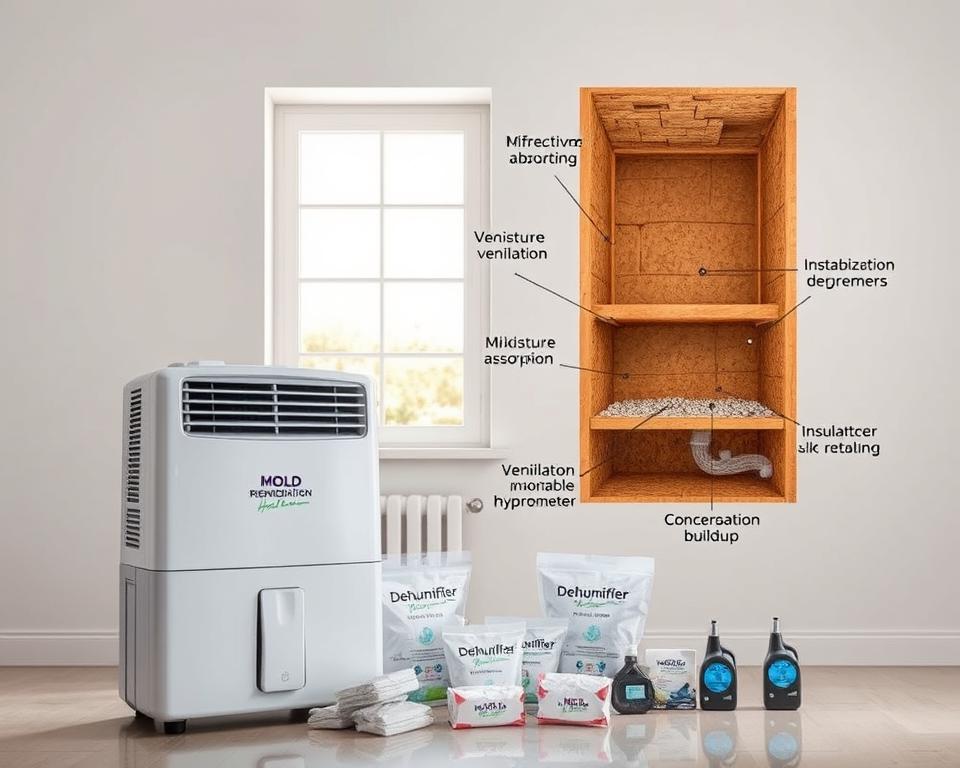
Start by monitoring indoor moisture levels with affordable hygrometers. The EPA recommends keeping relative humidity below 60% to inhibit spore development. Areas like basements and bathrooms often require:
- Dehumidifiers rated for room size
- Mechanical ventilation systems
- Moisture-resistant building materials
Proper airflow prevents stagnant conditions that encourage high humidity buildup. Install exhaust fans in kitchens and laundry rooms, venting them outdoors. For crawl spaces, consider vapor barriers and perimeter drainage systems.
| Humidity Range | Recommended Actions | Tools Needed |
|---|---|---|
| 30-50% | Routine air circulation | Ceiling fans, open windows |
| 50-60% | Targeted dehumidification | Portable units, desiccants |
| 60%+ | Professional assessment | Infrared cameras, moisture meters |
Regular inspections catch problems early. Check plumbing fixtures quarterly and address leaks within 48 hours. “Preventive measures cost 75% less than full remediation,” notes the Institute of Inspection Cleaning and Restoration Certification.
Seal cracks in foundations and upgrade insulation to combat condensation. These steps create long-term protection against high humidity challenges while improving energy efficiency. Document maintenance activities to identify patterns in moisture accumulation.
Conclusion
Addressing biological contaminants requires careful planning and expert guidance. Property owners must weigh factors like contamination severity, material porosity, and environmental conditions when budgeting for cleanup. Professional remediation services often deliver safer, longer-lasting results compared to temporary DIY fixes.
Accurate assessments remain critical for successful outcomes. Costs vary based on room dimensions, spore types, and required containment measures. Licensed teams use advanced tools like infrared scanners and air scrubbers to address both visible growth and hidden colonies.
Choosing certified specialists ensures compliance with safety protocols and industry standards. Their structured approach minimizes health risks while preventing cross-contamination. Homeowners gain peace of mind through warranties and post-treatment air quality tests.
Use the insights from this guide to evaluate service providers effectively. Prioritize transparent pricing models and documented success rates. A well-informed decision protects your property’s value and your family’s well-being for years to come.
